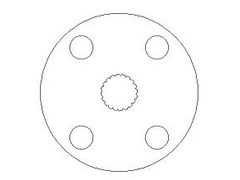Drew it up on CAD, sent hime the file, he cut it with the waterjet. Job done.
Spline pattern fits the input shaft of an escort gearbox. Outside PCD fits a propshat flange.


Rescued attachment Adaptor.jpg

As above, just out of curiosity really, does anyone know how internal splines would be machined? For example, the aperture that drive shafts fit into on sierra rear hubs.
Generally broached, long tapered profile tool pushed through component.
do you mean a hole that doesn't go all the way through the metal?
i had my side gears re done to a 18 spline larger than original diameter hole. it was done by wire spark erosion (i think its called)
http://www.youtube.com/watch?v=pab8MlMYNnc
...An example of broaching
Regards
Rob
Interesting, so it is a variation of a shaping machine.
I always thought that the broaching tool was the same size as the finished spline for some strange reason. (over active imagination I suppose!)
quote:
Originally posted by v8kid
Interesting, so it is a variation of a shaping machine.
I always thought that the broaching tool was the same size as the finished spline for some strange reason. (over active imagination I suppose!)
quote:
Originally posted by v8kid
Interesting, so it is a variation of a shaping machine.
I always thought that the broaching tool was the same size as the finished spline for some strange reason. (over active imagination I suppose!)
Andy of Waterjet fame made me an adapter with internal splines on it.
Drew it up on CAD, sent hime the file, he cut it with the waterjet. Job done.
Spline pattern fits the input shaft of an escort gearbox. Outside PCD fits a propshat flange.


Rescued attachment Adaptor.jpg
spline cutting on a waterjet is not recommended over 10mm unless you have a dynamic head...jet wash leads to a tapered finish and a waterjet doesnt
run much more accurate than .2mm....
broaching, wire erosion and spark erosion are the only true accurate was of reproducing any form of involute spline....
quote:
Originally posted by Alan B
quote:
Originally posted by v8kid
Interesting, so it is a variation of a shaping machine.
I always thought that the broaching tool was the same size as the finished spline for some strange reason. (over active imagination I suppose!)
Yes usually it is. Broaching is considered a relatively fast production process. Think of it more like milling but with a long straightened out cutter that usually takes one pass only.
quote:
Originally posted by boggle
quote:
Originally posted by Alan B
quote:
Originally posted by v8kid
Interesting, so it is a variation of a shaping machine.
I always thought that the broaching tool was the same size as the finished spline for some strange reason. (over active imagination I suppose!)
Yes usually it is. Broaching is considered a relatively fast production process. Think of it more like milling but with a long straightened out cutter that usually takes one pass only.
unless broaching a keyway, then shims are used to to take cuts in stages untill at the required depth....


quote:
Originally posted by boggle
quote:
Originally posted by Alan B
quote:
Originally posted by v8kid
Interesting, so it is a variation of a shaping machine.
I always thought that the broaching tool was the same size as the finished spline for some strange reason. (over active imagination I suppose!)
Yes usually it is. Broaching is considered a relatively fast production process. Think of it more like milling but with a long straightened out cutter that usually takes one pass only.
unless broaching a keyway, then shims are used to to take cuts in stages untill at the required depth....
me too....builds up the biceps.....
rich.....
no i dont have a broaching machine and i hate getting involved with spline nomenclature.....without all the info to create an involute it will never
be right...
quote:
Originally posted by boggle
me too....builds up the biceps.....
rich.....
no i dont have a broaching machine and i hate getting involved with spline nomenclature.....without all the info to create an involute it will never be right...


 Just kidding!!
Just kidding!!